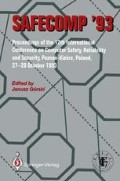Abstract
There is an increasing use of computing in safety related applications and ensuring that such systems are conceived, designed and produced with appropriate attention to safety is not easy. The process of identifying undesirable events and their consequences is known as hazard analysis. Carrying out a hazard analysis at varying stages during the development process is now being mandated in emerging standards produced by the International Electrotechnical Commission (IEC) [1] and the U.K. Ministry of Defence [2].
The case study reported here is part of a collaborative project between The Centre for Software Engineering Limited, Cambridge Consultants Limited and The Human Genetics Unit of The Medical Research Council.
Access this chapter
Tax calculation will be finalised at checkout
Purchases are for personal use only
Preview
Unable to display preview. Download preview PDF.
References
Functional Safety of Electrical/Eectronic/Programmable Systems. Generic Aspects. IEC 65A (Secretariat) 123. 1991
Interim DefStan 00-56. Hazard Analysis and Safety Classification of the Computer and Programmable Electronic System Elements of Defence Equipment U K Ministry of Defence 1991.
A Guide to Hazard and Operability Studies. Chemical Industries Association Limited, 1987.
Husain O, Watts K, Lorriman F et al. Semi-Automated Cervical Smear prescreening system: an evaluation of the Cytoscan-110. Analytical and Cellular Pathology, 5: 49–68, 1993.
HAZOPtimizer. Arthur D Little, Safety and Risk Management, Cambridge, Massachusetts.
Software through Pictures. Interactive Development Environments, California.
Chudleigh M, Catmur J. Safety Assessment of Computer Systems using HAZOP and Audit Techniques. In: Frey (ed) Safety of Computer Control Systems 1992 (Safecomp ’92) pp 285–292.
Author information
Authors and Affiliations
Editor information
Editors and Affiliations
Rights and permissions
Copyright information
© 1993 Springer-Verlag London Limited
About this paper
Cite this paper
Chudleigh, M. (1993). Hazard Analysis Using HAZOP: A Case Study. In: Górski, J. (eds) SAFECOMP ’93. SAFECOMP 1993. Springer, London. https://doi.org/10.1007/978-1-4471-2061-2_11
Download citation
DOI: https://doi.org/10.1007/978-1-4471-2061-2_11
Published:
Publisher Name: Springer, London
Print ISBN: 978-3-540-19838-3
Online ISBN: 978-1-4471-2061-2
eBook Packages: Springer Book Archive

